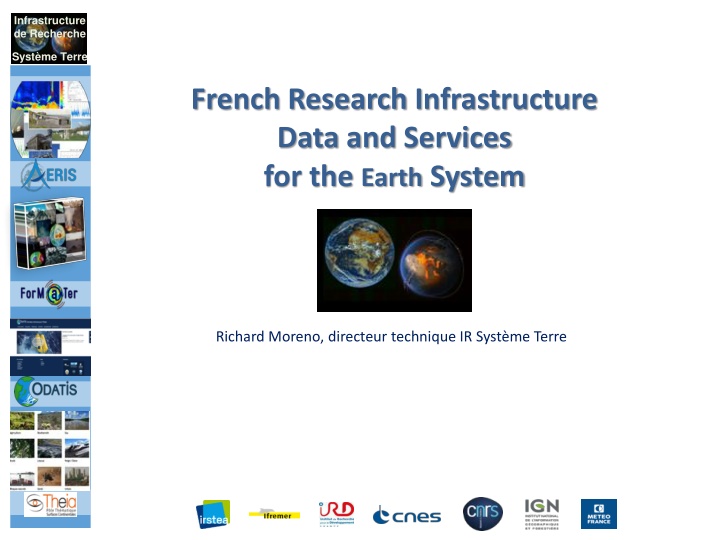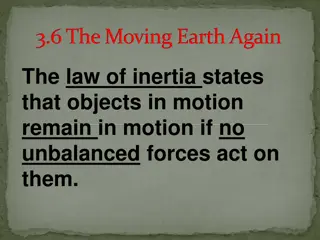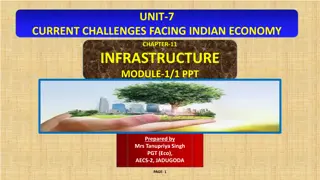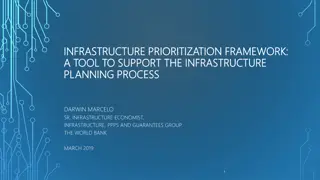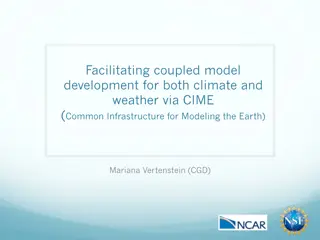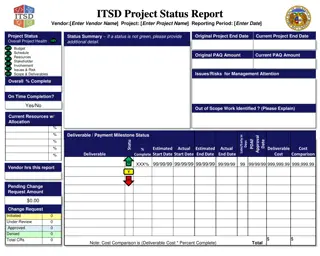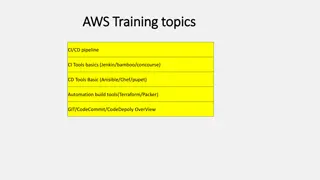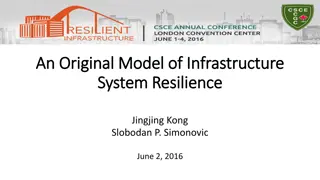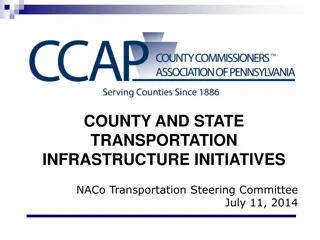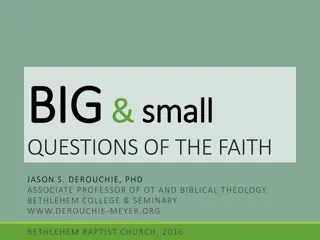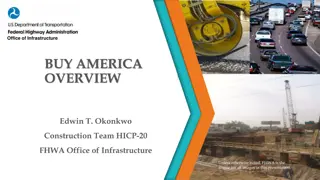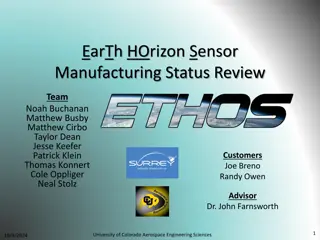Research Infrastructure for Earth System: Development and Status
The French Research Infrastructure for the Earth System, managed by Richard Moreno, focuses on data and services development. Plans include working groups, meetings, and key activities like data modeling and ontology development. The status of Data and Services Hubs is highlighted, showcasing collaboration with various satellite data sources and a growing volume of data. Additionally, the infrastructure's context within the European Open Science Cloud (EOSC) and implications for funding sources are discussed, including involvement from ESFRI, Ministries, and space missions. Considerations for integrating with commercial cloud services and existing infrastructures like INFRANUM and HPC are also explored.
Download Presentation

Please find below an Image/Link to download the presentation.
The content on the website is provided AS IS for your information and personal use only. It may not be sold, licensed, or shared on other websites without obtaining consent from the author.If you encounter any issues during the download, it is possible that the publisher has removed the file from their server.
You are allowed to download the files provided on this website for personal or commercial use, subject to the condition that they are used lawfully. All files are the property of their respective owners.
The content on the website is provided AS IS for your information and personal use only. It may not be sold, licensed, or shared on other websites without obtaining consent from the author.
E N D
Presentation Transcript
Infrastructure de Recherche Syst me Terre French Research Infrastructure Data and Services for the Earth System Richard Moreno, directeur technique IR Syst me Terre
2 Plan de d veloppement Infrastructure de Recherche Syst me Terre Groupes de r flexion / travail Comit de direction GT_TECH : r unions toutes les 3 semaines environ Interpole ENVRI FAIR
3 Plan de d veloppement Infrastructure de Recherche Syst me Terre Activit s prioritaires & en cours Catalogue & mod le de donn es & thesaurus & ontologies D marr dans le cadre Interpole Authentification & autorisation DOI Licences (Interpole) Outils entrep ts de donn es et diffusion avanc e (dataverse) ~datalake Infrastructures / architecture => preparation r ponse PIA3
4 Status of the Data and Service Hubs Infrastructure de Recherche Syst me Terre 4/5 Data and Services Hubs (AERIS, FORM@TER ODATIS, THEIA & PNDB) Very different Not the same level of FAIRisation Data from French / European satellites, but also from other countries (NASA, JAXA, USGS, NOAA, ) In-situ data, models, Each Hub is distributed among several data & services centers The current state of the Data & Services Hubs is to be taken into account The volume of data is increasing A mandate to open up to the downstream sector A few figures ~20 Data & services infrastructures 30 CES : scientific expertise consortium 50 000 TB (2017) - 100 0000 TB (2022) 350 scientists, data scientists, engineers, technicians - 170 FTE full time equivalent In progress & in discussion: 5th data & Services hub on biodiversity : PNDB
Contexte des infrastructures 5 Infrastructure de Recherche EOSC Incontournable INFRANUM Incontournable Syst me Terre Fortes sources de financement Implication des ESFRI dans EOSC Directive des Minist res DIAS ESA & WeKEO A considerer Certains AO pourraient imposer l utilisation des DIAS Int grer WeKEO nous permettrait de nous rapprocher des donn es m t o et climat et de disposer ventuellement de moyens cloud commerciaux proximit pour les usages aval Les infrastructures en place dans les p les A consid rer Sur la dur e et selon ce qui sera faisable avec INFRANUM (contraintes du monde HPC) PEPS Utilis par THEIA Form@ter dans le cadre projet Etalab Compatible CREODIAS pas avec les autres DIAS CNES HPC & Datalake Missions spatiales : gros volumes
6 Technical harmonization Infrastructure de Recherche Syst me Terre Paradigm change from CNES point of view Satellite data is not anymore the main source of data The user community is not only the scientists close to space agencies (eg PIs) => Classical standardization forums (CEOS, GEO, ESA DCB, NASA, OGC, ISO, ) are still useful Standardization forums of Science / Earth Science Interpole working group Created in 2014 to promote technical exchange between the Data & Service Hubs A two-days workshop every 6 months Example of topics Long term preservation, Authentication & Authorization, catalogues, formats, DOI, Licenses, processing, RDA Research Data alliance 95 working groups ! RDA Europe deeply involve in EOSC H2020 : ENVRI+ / ENVRI FAIR in an ESFRI context ENVRI & ENVRI FAIR similar to Interpole at European level Work on progress to combine both activities GO FAIR initiative in the context of EOSC Germany + France + The Netherlands Interoperability of processing chains ?
Rponses AO Europens Infrastructure de Recherche Syst me Terre PHIDIAS R ponse AO CEF (mi-novembre) WP1 : Management WP2 : Compute and storage workflow management WP3 : Technical coordination, development of the common system WP4 : Intelligent screening of large amount of satellite data for detection and identification of anomalous atmospheric composition events WP5 : Big data EO: processing on-demand for environment monitoring WP6 : Ocean Use case WP7 : Dissemination, Impact and Sustainability Path Pas plus d informations ici car confidentiel
Rponses AO Europens Infrastructure de Recherche Syst me Terre Part. N Participant organisation name Country 1 2 3 4 5 Consortium GARR (GARR) Consiglio Nazionaledelle Ricerche (CNR) CINECA Consorzio Interuniversitario(CINECA) Istituto Nazionaledi Fisica Nucleare (INFN) Fondazione Centro Cambiamenti Climatici (CMCC) Universit t Wien (UNIVIE) Centre Informatique National de l Enseignement Sup rieur (CINES) Centre National de la Recherche Scientifique (CNRS) Italy Italy Italy Italy Italy Euro-Mediterraneo sui Work packag e No 1 2 Work Package Title 6 7 Austria France 8 France Management 9 Institut National de la Recherche Agronomique (INRA) Institut National de la Recherche en Informatique et Automatique (INRIA) Institut Francais de Recherche pour l Exploitation de la Mer (IFREMER) Institut National de la Sant et de la Recherche M dicale (INSERM) KarlsruherInstitut f r Technologie (KIT) Deutsches KlimarechenzentrumGmbH (DKRZ) Fraunhofer Gesellschaft Angewandten Forschung e.V..(Fraunhofer) Helmholtz Zentrum Geoforschungszentrum(GFZ) Gent University (UGENT) Trust-IT SRL (TRUST-IT) France The human factor of the EOSC: Dissemination, Outreach and Community building 10 France 3 4 National Initiatives Survey From National Initiatives to trans-national services The Data layer: establishing FAIR data services at the national and transnational level EOSC in action: Use cases and community- driven pilots The infrastructure layer: delivering horizontal data storage and computing services, from national to transnational 11 France 12 France 5 13 14 15 Germany Germany Germany 6 zur F rderung der 7 16 Potsdam, Deutsches Germany 17 18 Belgium Italy
Infrastructure de Recherche Syst me Terre Technical Solution 9
Infrastructure de Recherche Overarching principle of operation Syst me Terre Main motivation of the Earth System Research Infrastructure not to re-invent the wheel but to take benefits on existing initiatives by improving the standardization and the interoperability of the systems already in place. Base developments on open source software with wide communities Improve transdisciplinarity and across domain interoperability. Provide services on both space data AND in-situ data.. Take into account the evolution of the computing infrastructure landscape in France (Infranum) and in Europe (EOSC, DIAS, ...) and to be able to integrate into this ecosystem. Re-use of what has been done in each Data and Services Hubs (ODATIS, THEIA, ). In order to encourage this re-use and to push for the sharing of practices, a working group (named Interpole) was set up four years ago. technical experts from each Hub to explore technical topics of common interest DOI, Long Term Preservation, Catalogue, Format, SSO, processing, this work takes in account and implements the recommendations established by the Working Groups of the Research Data Alliance (RDA). 10
Infrastructure de Recherche Inspiring models Syst me Terre NASA EOSDIS hub Common Metadata Repository / Unified Metadata Model Combined with their progressive migration toward cloud computing Hub Pangeo (~datacube) Already used for atmosphere, ocean and climate data GeoDAB: GEOSS data hub EuroGEOSS, AmeriGEOSS, NextGEOSS CKAN & cloud computing capabilities ESA DCB Initiative: Network of Exploitation platforms And their cloud initiatives: DIAS, TEP/MEP/MAP ENVRIfair H2020 project Naturally linked to EOSC French Data&Services Hubs are part of the consortium IAGOS, ACTRIS, EURO-ARGO, EPOS, EMSO, ANAEE, SeaDataCloud, 11
Processing Topology Infrastructure de Recherche Syst me Terre Increase of data volumes => better to bring the processing close to the data Not for everyone; downloading data is still an option Cf Copernicus dissemination statistics Very interesting for newcomers (eg startup, ) Mandatory for very big volumes e.g. NISAR Need to combine data from different compartments => have data very close from each other In the same cluster e.g. NASA EOSDIS evolution (AWS) & Copernicus CGS evolution In a limited number of cluster linked with high speed network e.g. : WeKEO, Current CGS architecture, AERIS/ESPRI, INFRANUM (AC), EOSDIS (DAAC) Distributed in several data centers not linked with HS network Use ad-hoc technologies to give unity to the system e.g. Ceph object storage / IRODS / Increasing distance 12
Help desk - User support - Developer support - Project support - Animation centers Other data Infrastructure de Recherche - Linked data - socioeconomic - Social media Catalogue Thesaurus & Knowledge & Tagging services Data model Syst me Terre Identity server Hosted processing & online data http Execution Management Service Application Deployement & Execution Service Advanced visualisation services DOI server Users Data Producers & distributors Data Access Portal Web services Pre-analysis Services: Datacube CDS Data & services Structured observations Data curation Data production Re-processing Expertise for HD "Datalake" Data management opensearch e.g WPS, WMS Jupyter, SNO, IR, TGIR, ESFRI Satellite Harvester AD Third Parties observations GEO-DCAT Data & processing chains NASA EODIS NASA coverage Copernicus Data repository & publication service Multi-source big data Infrastructure Other processing resources Individual observations Partners CNES, IFREMER, IGN, Long Term Preservation In situ CDIAS - SSO & AAI & DOI - QoS surveillance - Usage analytics Transversal services
Key ideas Infrastructure de Recherche Syst me Terre Strong and operational help desk To support users e.g. allow feedback on datasets e.g. present locally : CART To help set up new projects : Development support Support to data and processing migration Capacity building : AI, Cloud computing, coding language, orchestration, DevOPS, Collocate data as far as possible To ease the combination between data from different compartments As a consequence of the bringing the processing close to the data paradigm Datalake technologies smooth/efficient data management tool CNES datalake | ENS(Elastic Node Server)/dhus (ESA) | AERIS/ESPRI (Ceph, ), NASA EOSDIS, Operational and trustworthy catalogue of data & services Foster interoperability between processing platforms DIAS, EOSC, INFRANUM, PRACE, Not techno push Need from users and IR ST strategy Quality of service IR ST system monitoring / analytics FAIRisation of data 14
Data: IR ST data catalog Infrastructure de Recherche Syst me Terre A unique, operational catalog Containing all data metadata and pole services Like the NASA EOSDIS CMR (https://earthdata.nasa.gov/about/science-system-description/eosdis- components/common-metadata-repository) Requires a unified data model (~ UMM NASA & HMA ESA) Taking into account spatial data, in-situ, models, ... Based on ISO and Inspire recommendations for example Work in progress as part of the Interpole catalog WG Vocabularies / ontologies adoption and maintenance of commonly agreed vocabularies and ontologies, set up of standardized vocabulary servers With interfaces interoperable INSPIRE, CEOS opensearch, Linked data / RDF, Geo DCAT, WIGOS / WMO standards, ... Adaptable (nothing is fixed) Two step search: collections then granules CEOS connected data assets, GEOS, NASA EOSDIS, ESA FedEO, ... 15
Processing Infrastructure de Recherche Syst me Terre Centralized / common way for multi-source treatments => Cf INFRANUM Offer cloud compatible technology solutions Ability to launch projects on DIAS and EOSC => processing interoperability (ex: EOPEN or OPENEO or NextGEOSS) To answer calls for projects UE and ESA Compatibility of RI interfaces with DIAS and EOSC Propose (after user needs analysis) An innovative solution for data analysis like: datacube + Jupyter Pangeo Knowledge graph SeaScope (Ocean Datalab) Strong Artificial intelligence capacities 16
Infrastructure de Recherche Syst me Terre Technical Strategy 17
Computing Infrastructures Target = INFRANUM Progressive but determined approach Migration when data is used in a transverse IR ST framework (SCO example) Migration when IT means become obsolete Some datasets may not be migrated Old and little used Necessary proximity of the producer in case of a reasonable data volume: case of certain in-situ data => concept of technical cache Infrastructure de Recherche Syst me Terre Ability to be distributed across multiple sites At the beginning the IR ST will still be spread over several CDS themselves distributed over several sites On opportunities to be able to switch to external means like DIAS or EOSC Eg for European projects Need for adaptation & fine analysis INFRANUM HPC : not compatible with the IR ST way of working => need for adaptation of INFRANUM centers to be able to cope with HPDA or HTC All IR ST compute services may not be able to join INFRANUM Even if there is an evolution of INFRANUM Analysis & discussion with INFRANUM are necessary 18
Computing Infrastructures Infrastructure de Recherche Syst me Terre INFRANUM not operational within 3 years Target is also EOSC How is it compatible ? Intermediate step on relatively limited means Temporary infrastructure to choose CINES : EUDAT => EOSC CALMIP or any regional or National (IN2P3, ) INFRANUM center CNES IFREMER, IGN, any IR ST CDS infrastructure DIAS EOSC EUDAT, EGI, A way to learn and validate the consideration of user needs Software for the intermediate stage Limit specific developments (at least for this step) Catalog and data hub (CKAN, NASA CMR, CNES datalake, ...) 'Modern' means of processing data: Datacube + Jupyter / Pangeo / ... Rapid Implementation of Development / Migration Support service 19
Computing Infrastructures Infrastructure de Recherche Syst me Terre Il est illusoire de penser que l IR ST pourra tre concentr sur un seul et unique MesoCentre d INFRANUM. Mais une fois INFRANUM en place la distribution de l IR sera limit e aux M soCentres r gionaux et nationaux Bretagne Haut De France Calmip (Occitanie) Avec prise en compte des MesoCentres nationaux IDRIS, CINES, IN2P3 Notamment pour la combinaison des donn es tr s volumineuses Et / ou besoin de tr s gros moyens de calculs D o une architecture distribu e Pour les donn es Et les traitements Avec les solutions techniques aff rentes 20
